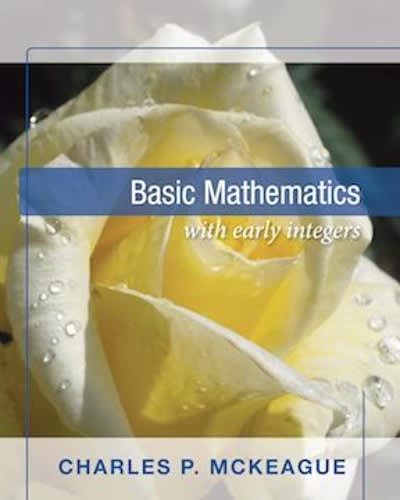Question
If you computed a chi-square of 4.0 with df = 1, would you accept the null hypothesis? Explain. If you computed a chi-square of 4.0
- If you computed a chi-square of 4.0 withdf = 1, would you accept the null hypothesis? Explain.
- If you computed a chi-square of 4.0 withdf = 3, would you accept the null hypothesis? Explain.
3. Why do we consider the Hardy-Weinberg equilibrium to be a null hypothesis?
4.In the garden pea, purple flowers are dominant to white. When Mendel crossed the F1 generation, he obtained 705 purple and 224 white offspring. Use the2-test to determine whether these results support the hypothesis that the F1s were heterozygotes, as they should have been. Be sure to state the null and the alternative hypotheses.
5.In Shorthorn cattle, the genotype CRCR is phenotypically red, CRCW is roan (a mixture of red and white) and CWCW is white. (a) If 108 red, 48 white and 144 roan animals were found in a sample of Shorthorns from the central valley of California, calculate the estimated frequencies of the CR allele and the CW allele in the gene pool of the population. (b) If this population is completely panmictic (meaning random-mating), what zygotic frequencies would be expected in the next generation? (c) Use the2-test to determine whether the population is in Hardy-Weinberg equilibrium. Be sure to state the null and alternative hypotheses.
6.In a dihybrid cross, Mendel crossed two true-breeding types of peas: yellow, round peas and green, wrinkled peas. Plants in the first filial (F1) generation all produced yellow, round peas. When F1pea plants were crossed with each other, the F2 generation included 315 with yellow, round peas, 108 with green, round peas, 101 with yellow, wrinkled peas, and 32 with green, wrinkled peas. According to Mendel's laws the expected ratio is 9:3:3:1. Are the expected and observed values significantly different? Do a2-test to answer this question.
7.In a population of wild gardenias, purple flowers show incomplete dominance to white. You survey the population and find 705 plants with purple flowers, 224 plants with white flowers, and 455 plants with light purple flowers. Use the2-test to determine whether these results support the hypothesis that the population is in Hardy-Weinberg equilibrium. Be sure to state the null and the alternative hypotheses.
8. Ross's goose is a small Arctic nesting goose. Goslings (baby geese) exist in two color morphs, grey or yellow. A population of geese at Karrack Lake, Canada included 490 yellow goslings and 510 grey goslings (1000 total). They assumed that color is controlled by two alleles at a single locus. A) Calculate the frequencies of the two alleles, assuming that the grey goslings have the dominant allele and that the population is in Hardy-Weinberg equilibrium. B) Calculate the frequencies of the heterozygous genotype, assuming that the grey goslings have the dominant allele and that the population is in Hardy-Weinberg equilibrium. C) Use the2-test to determine whether these results support the hypothesis that the population is in Hardy-Weinberg equilibrium. Be sure to state the null and the alternative hypotheses.
9) You are a sciurologist (a scientist that studies squirrels) and you are studying the frequency of white squirrels in the area around Brevard, NC. White squirrelsexhibit a rare white fur coloration known asleucism that is as a result of a recessive gene found within certain eastern gray squirrel (Sciurus carolinensis) populations. You take dropping samples and are able to genotype all the squirrels. You find:
- 361 gray homozygous squirrels, WW
- 553 gray heterozygous squirrels, Ww
- 336 white squirrels ww
A) Calculate the frequencies of the two alleles, assuming that the population is in Hardy-Weinberg equilibrium. Please show your work. B) In your study, you are interested in whether your population is in Hardy Weinberg Equilibrium because there is a heterozygote advantage in leucism. What do you report to your colleagues (remember, you would never report anything to scientific colleagues without using statistics!)? Please show your work.
10) White merino wool is dependent upon a dominant allele R and black merino wool upon its recessive allele r. Suppose that a sample of 1000 sheep of theRambouilletsheep breed in Idaho gave the following data: 590 white and 410 black. Assume that color is controlled by two alleles at a single locus. A.Calculate the frequencies of the two alleles,assuming that the population is in Hardy-Weinberg equilibrium. B. Calculate the frequencies of the heterozygous genotype, assuming that heterozygotes are white and that the population is in Hardy-Weinberg equilibrium. C) Use the2-test to determine whether these results support the hypothesis that the population is in Hardy-Weinberg equilibrium. Be sure to state the null and the alternative hypotheses.
Step by Step Solution
There are 3 Steps involved in it
Step: 1

Get Instant Access to Expert-Tailored Solutions
See step-by-step solutions with expert insights and AI powered tools for academic success
Step: 2

Step: 3

Ace Your Homework with AI
Get the answers you need in no time with our AI-driven, step-by-step assistance
Get Started


